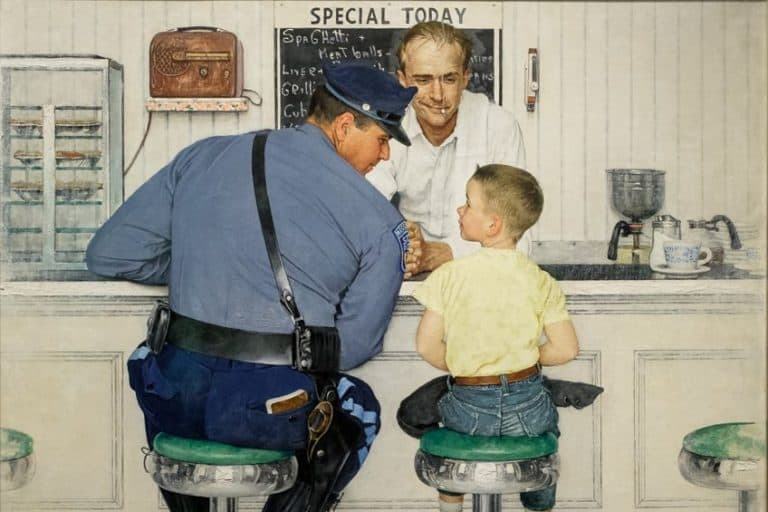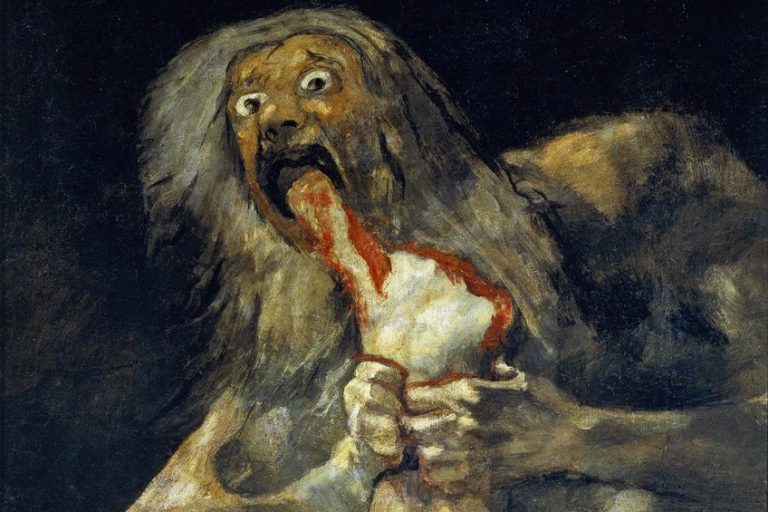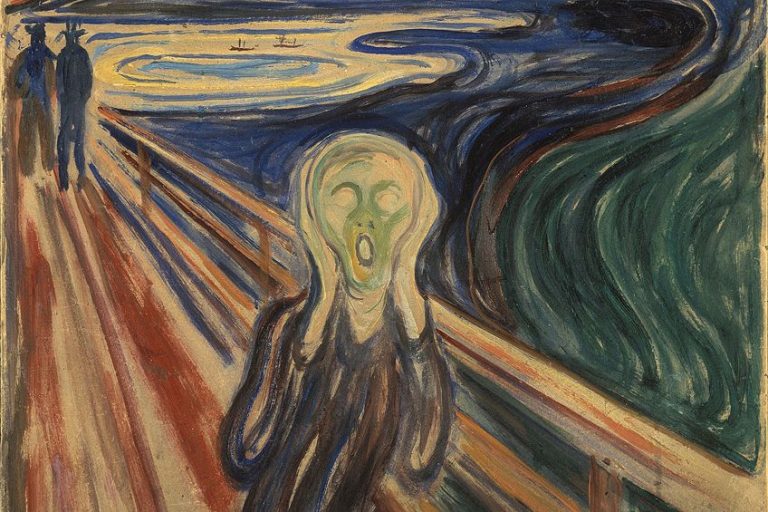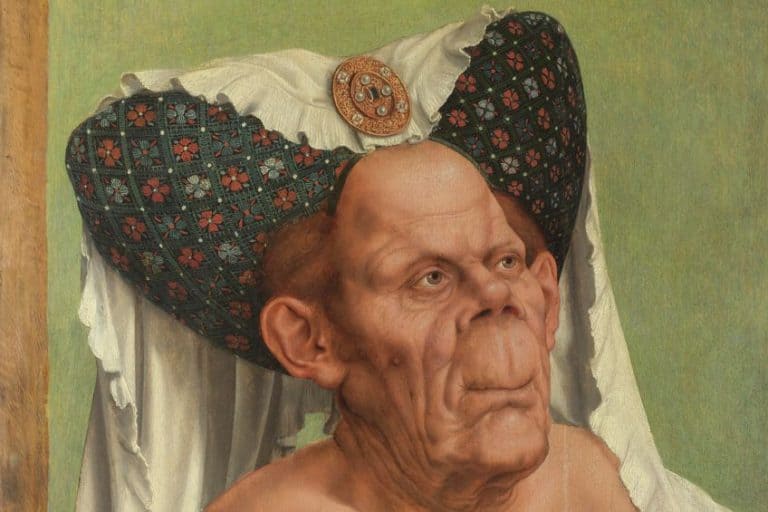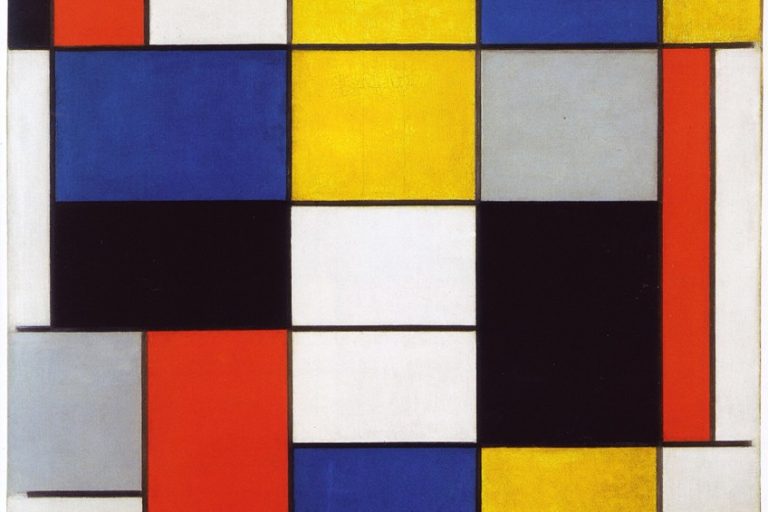A Sunday Afternoon on the Island of La Grande Jatte – An Analysis
Everyone loves a lazy Sunday afternoon, lounging, lying, and staring into the distance. In this article we take you to the “Island of the Big Bowl”, otherwise known as Île de la Grande Jatte, just outside Paris. This will not just be any lazy Sunday afternoon, but one depicted by the Neo-Impressionist Georges Seurat, in his painting A Sunday Afternoon on the Island of La Grande Jatte (1884 to 1886).
Artist Abstract: Who Was Georges Seurat?
Georges Pierre Seurat was born in 1859 on 2 December, in Paris. Seurat had two siblings, one brother, and one sister, both were older than him. He was interested in art from a young age and during 1875 he first studied at École Municipale de Sculpture et Dessin, which was the local municipal art school; he studied under Justin Lequien.
In 1878 he started studying at the École des Beaux-Arts and left during 1879 due to his service in the military. Seurat extensively studied color and how this was perceived, which led to his techniques called Pointillism and Divisionism. He was also influenced by the brushwork and color techniques utilized by the Romantic artist Eugène Delacroix. Seurat died when he was 31 years old in 1891.
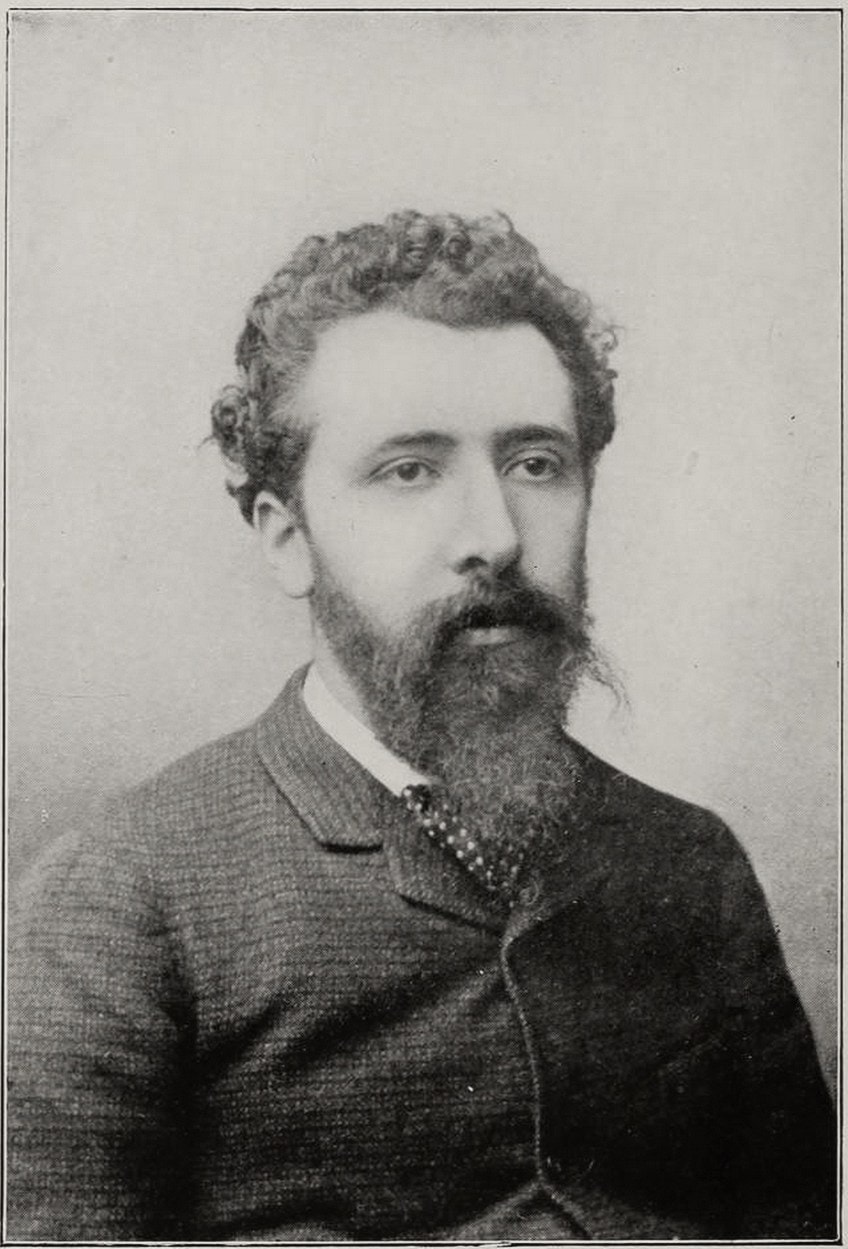
A Sunday Afternoon on the Island of La Grande Jatte In Context
Although Georges Seurat did not produce many paintings during his short lifetime, he certainly left an impact on the world of art, creating artworks that were not only aesthetically grand but artistically astute. He was remembered as one of the first artists to innovate color theory and to apply it to his paintings, moving away from the Impressionist style that dominated the time.
In this article below we will explore Seurat’s A Sunday Afternoon on the Island of La Grande Jatte analysis a little bit further. We will start with a contextual analysis, discussing when Seurat painted A Sunday on La Grande Jatte and how he ushered in a new style called Neo-Impressionism.
We will then look at a formal analysis of the painting itself and discuss the subject matter in more detail as well as formal elements like color and brushwork, which are important aspects of this artwork.
| Artist | Georges Seurat |
| Date Painted | 1884 |
| Medium | Oil on canvas |
| Genre | Genre painting |
| Period / Movement | Neo-Impressionism |
| Technique | Pointillism, Divisionism |
| Dimensions | 207.6 x 308 centimeters |
| Series / Versions | Not applicable |
| Where Is It Housed? | Art Institute of Chicago |
| What It Is Worth | Not available |
Contextual Analysis: A Brief Socio-Historical Overview
Neo-Impressionism was all about new narratives in art and this underpinned Georges Seurat’s artwork oeuvre. For us to understand Seurat’s revolutionary painting, A Sunday on La Grande Jatte it is important to know what shaped him and essentially his art.
Seurat studied at the École des Beaux-Arts in Paris from 1878 to 1879, and this undoubtedly gave him classical training in Academic art and the rules related to it.
During this time in Paris, the academic art institutions and the main exhibitory body available for artists, which was the Salon, had a ruling place in the art world and determined for many artists what art would be acceptable to exhibit and essentially create.
The École des Beaux-Arts started in 1648 and many great artistic names studied there, for example the Romanticism Théodore Géricault and Eugène Delacroix, the Neo-Classical Jean Auguste Dominique Ingres, the Impressionists Pierre-Auguste Renoir and Edgar Degas, and many more.
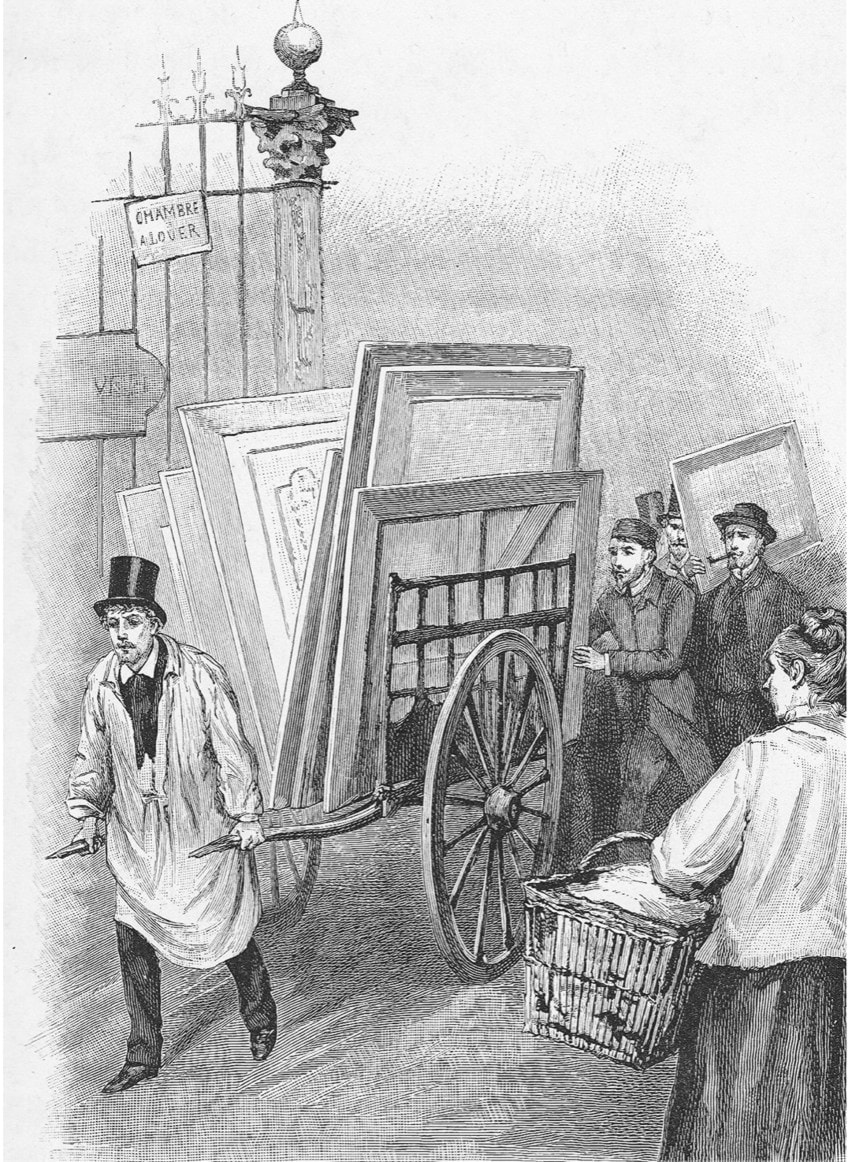
With this, there was a level of conservatism and artistic standards to uphold, and a rigorous set of hierarchies that distinguished high art from low art in terms of genres. The most acceptable genres were History paintings and Portraits, the first would have conveyed a moral message, usually through depicting Biblical and mythological figures. Other genres like landscapes and Still Lifes were not deemed as important.
Furthermore, pupils’ studies for their art practice started with extensive drawing techniques before furthering to painting.
This also followed the artistic rules, or canons as it is referred to in the art world, from the Classical era. Pupils also copied from Classical sculptures and paintings of Renaissance artists as part of their practice, additionally, they drew from casts and models.
It is therefore safe to say that the artists who attended the École des Beaux-Arts undoubtedly would have experienced the more conservative and traditional approaches to art, creating artworks that were realistic and near to perfectly executed in terms of formal qualities. This was as expected at the time and what was acceptable.
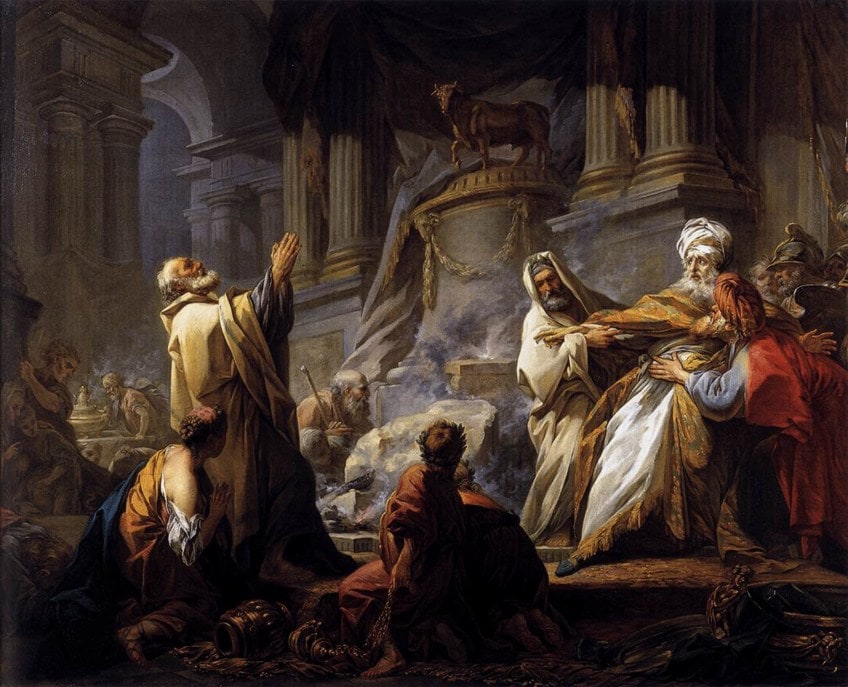
Did this leave any room for innovation or, ironically, creativity? It probably did not as much as some would have liked, and many artists who diverged from the strict conventions of the Salon and the Académie des Beaux-Arts and created their own styles were rejected from the major Salon exhibitions.
This is when a few artists came together during 1873 and started the group called Société Anonyme Coopérative des Artistes, Peintres, Sculpteurs, Graveurs, in English known as the “Cooperative and Anonymous Association of Painters, Sculptors, and Engravers”.
This group of artists exhibited independently and were able to showcase their new styles that were landscapes and everyday scenes that digressed in many ways from the traditional art of the Academy.

This group would come to be known as the Impressionists, and they exhibited between 1874 and 1886. A large part of their style was described as en plein air meaning “outdoors”. We see this in many paintings from artists like Claude Monet, Pierre-Auguste Renoir, Edgar Degas, although Degas did not identify as an Impressionist per se, and many more.
Furthermore, the Impressionists painted in various new ways, applying the paint more haphazardly to convey the essential aspects of the subject matter, there was also a focus on applying colors to convey light and dark and to achieve a natural effect.
This was all revolutionary at the time, even the subject matter was more modern, including everyday people and places and not Biblical scenes or Goddess-like nudes.
From Impressionism to Post-Impressionism
Post-Impressionism, as the name implies, was a result of Impressionism. Naturally, some artists did not feel the same way as the Impressionists about making art and started employing different techniques. Among the Post-Impressionists were the Neo-Impressionists, which is where Georges Seurat fits in.
It was during this time, around 1885, that Georges Seurat exhibited his painting Bathers at Asnières (1884) to the Academy’s Salon, but it was rejected due to its subject matter, specifically depicting men that were from the working-class Paris.

During 1884 or 1885 Seurat and other artists like Paul Signac, Odilon Redon, and Albert Dubois-Pillet started the group Société des Artistes Indépendants meaning “Society of Independent Artists”. This group also exhibited independently from the Salon and was the start of Neo-Impressionism.
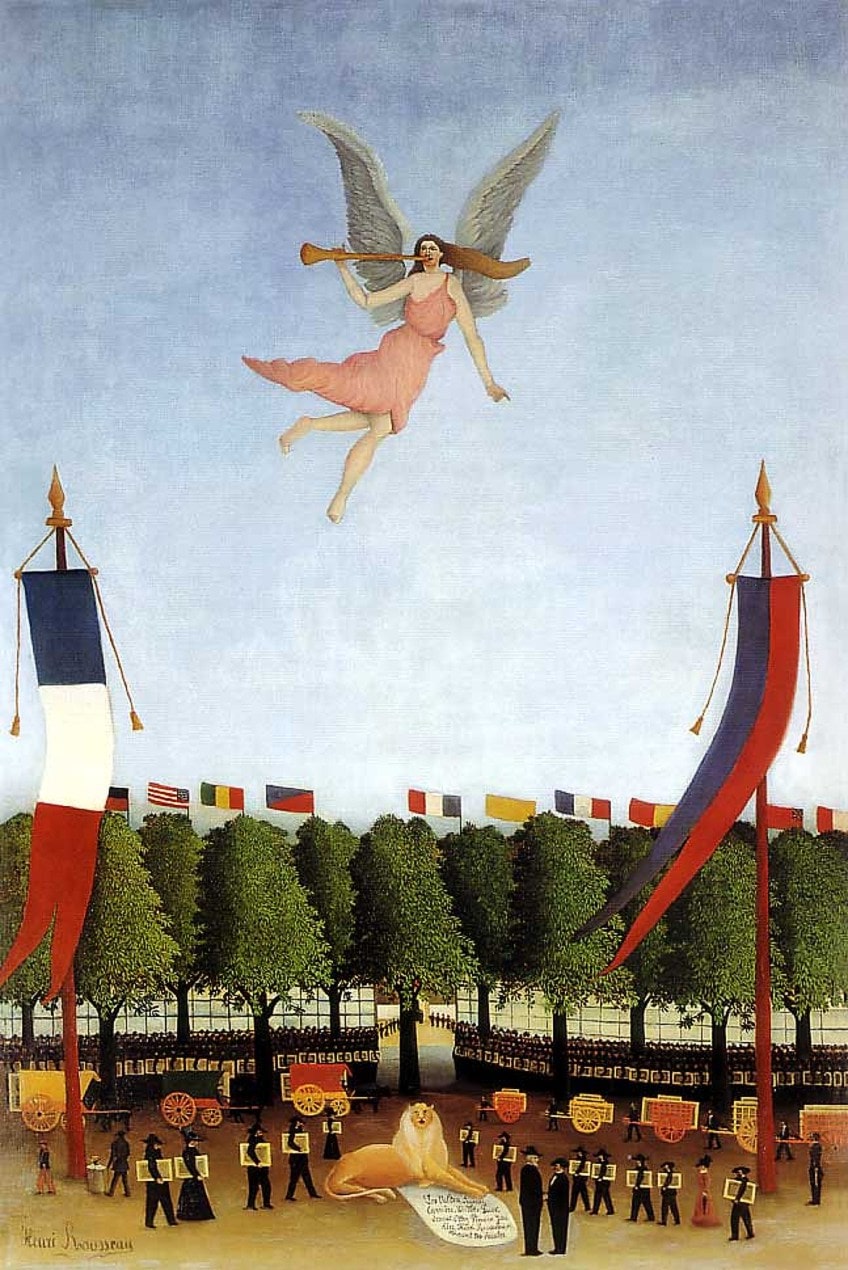
Neo-Impressionism reportedly developed around the last Impressionist exhibition, which was during 1886. Seurat exhibited A Sunday on La Grande Jatte during this last exhibition as well as in the Société des Artistes Indépendants exhibitions.
Félix Fénéon, who was an art critic and writer, started the term Neo-Impressionism when reviewed the new style of painting that emerged amidst the Impressionism style. These were primarily the paintings of Georges Seurat and his esteemed friend Paul Signac, who was also an avid admirer of Seurat’s artwork.
“My System”: Pointillism and Divisionism
Seurat was remembered as saying that he wanted to find “something new, my own way of painting”. He certainly found a new way and in fact, a “system” as he referred to it. He has also been quoted as saying, “They pretend to see poetry in my work, but they are wrong. I simply apply my system”.
For the painting A Sunday Afternoon on the Island of La Grande Jatte, Seurat studied his subject matter extensively and reportedly made over 20 preparatory panel oil paintings, over 20 drawings, and preparatory canvases. Seurat also visited the La Grande Jatte and reportedly completed it in two years.
This indicates the level of precision that Seurat took to apply what he believed was his “system” and a new way of painting, which was called Chromoluminarism, otherwise referred to as Pointillism or Divisionism.
Seurat was not only influenced by stylistic applications of Delacroix but also read various theoretical texts on color theory, for example, Michel Eugène Chevreul and his publications about the laws of colors and their contrast, one of Chevreul’s notable books have been The Principles of Harmony and Contrast of Colours and their Application to the Arts (1839).
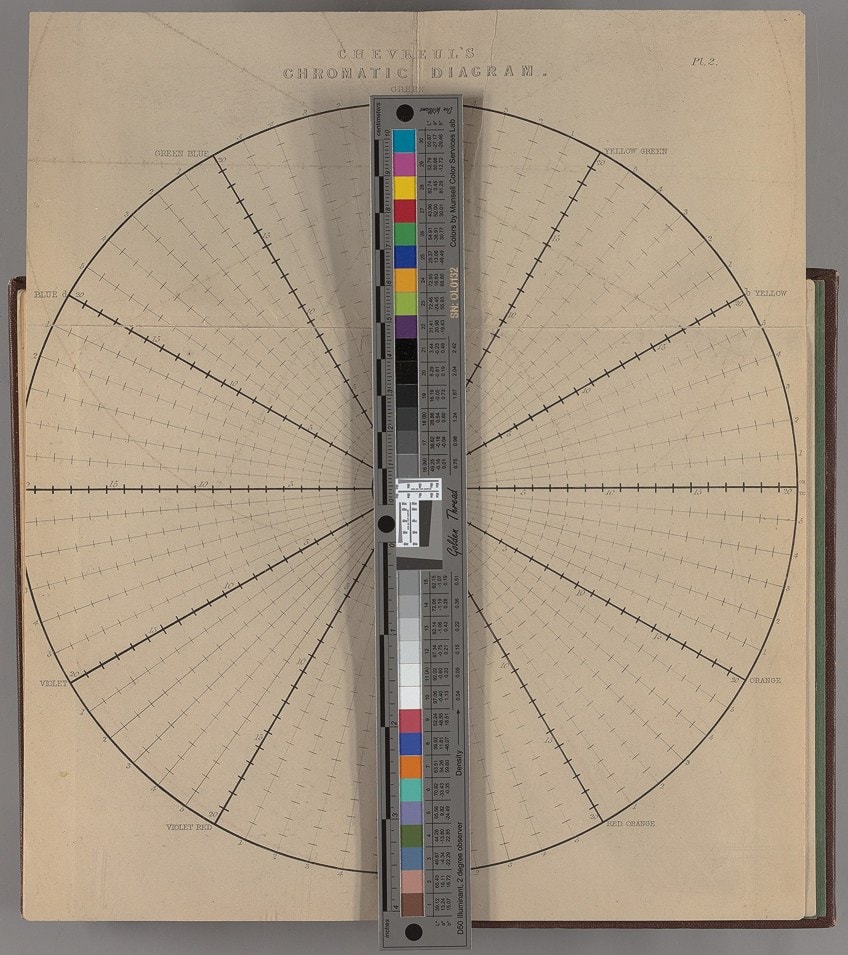
For Seurat, Pointillism consisted of painting dots that would make up the composition, however, the application of color was very important to obtain a “luminous” effect. Colors would be applied next to the other and unmixed.
It was believed mixing colors to obtain another color created undesirable shades and by placing colors next to the other by means of strokes or dots the viewers’ eyes would naturally combine the colors to create the desired shade and ultimately a more “vibrant” appearance.
Seurat was remembered as being meticulous about his process of application and carefully placed the dots next to the other. This we will look at in closer detail when looking at the formal aspects and technique of A Sunday Afternoon on the Island of La Grande Jatte analysis.
Formal Analysis: A Brief Compositional Overview
Georges Seurat once told the French poet and art critic, Gustave Kahn, “The Panathenaeans of Phidias formed a procession. I want to make modern people, in their essential traits, move about as they do on those friezes, and place them on canvases organized by harmonies of color, by directions of the tones in harmony with the lines, and by the directions of the lines” – an apt description of his artwork, by Seurat himself. Below, we discuss the subject matter and color techniques of A Sunday on La Grande Jatte in more detail.
Subject Matter
We see a scene of modern Parisian life during the late 19th century in Georges Seurat’s famous La Grande Jatte painting. There are women, men, children, and animals on an embankment of green grass with the River Seine to the left, with a variety of sailing boats and yachts; we can even see some with rowers in them.
There are well over 30 people in this scene and when looking closely, everyone is going about their own leisurely business. In fact, what has made this painting so controversial was that Seurat depicted the figures without a sense of engagement or emotion.
The figures appear still and standing as if they do resemble the figures we see from Egyptian or Greek friezes, as Seurat said from the above-mentioned quote.
To the far right, we see a woman and man standing tall and upright as if setting the scene as our gaze moves across the rest of the composition. The woman is holding what appears to be a black parasol in her right hand and a thin string in her left hand, which is a leash for the capuchin monkey at her feet; there is a dog seemingly running away from the monkey.
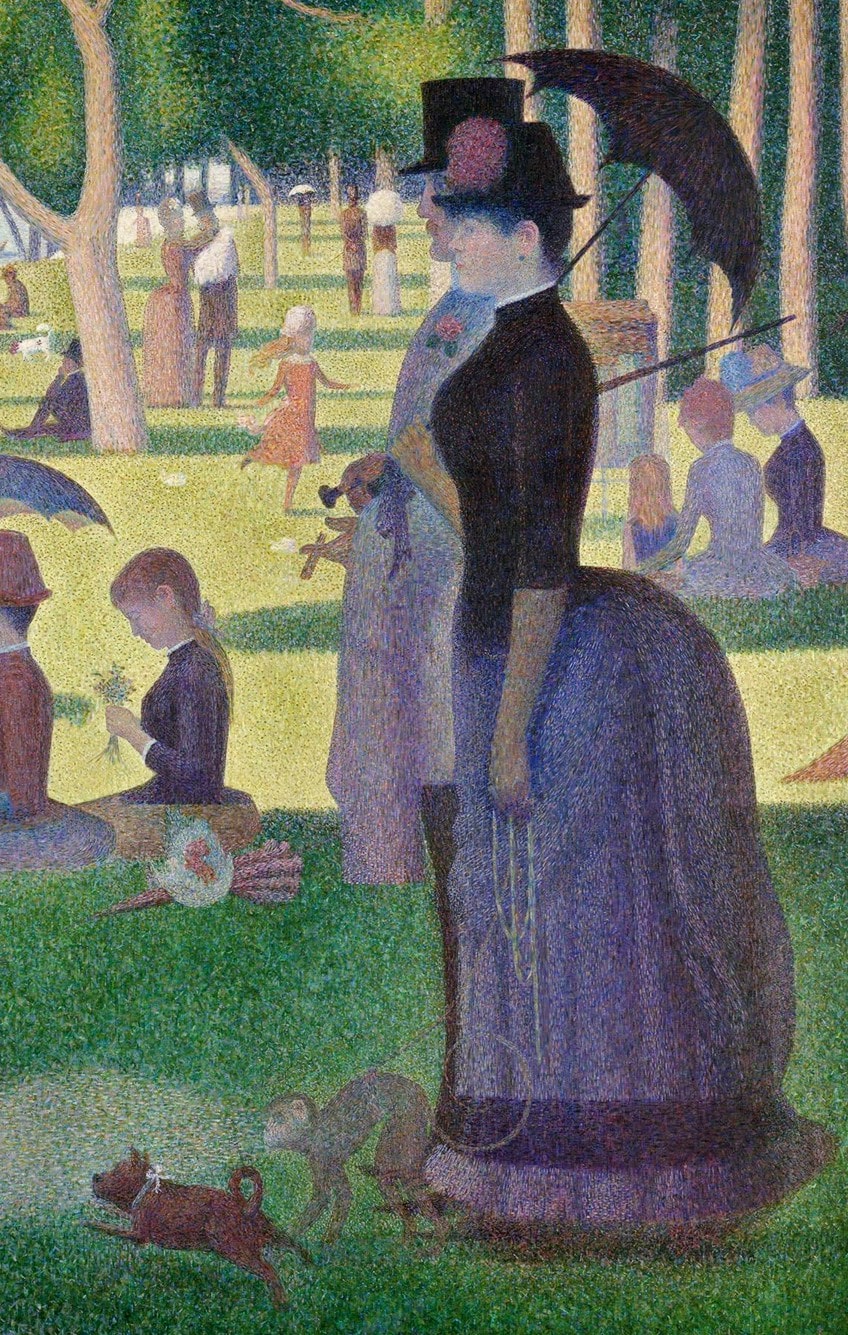
We see another bigger dog directly across these two standing figures, sniffing at something on the grass where three more figures are casually relaxing: a man half lying down resting on the back of his forearms and elbows holding a pipe in his mouth with his right hand, a woman sitting next to him busying herself with a white napkin or cloth, possibly knitting, and next to her is a man sitting with his knees up, holding a walking stick in both hands and looking out in front of him.
If we move further along, we will also notice the figures in the forefront are standing and sitting in a shaded area created by an unknown source that is not in the composition. This is possibly from the trees, which we see more towards the right of the scene. However, there are solitary trees dispersed along the entire embankment.
We will notice a woman standing near the river edge with a fishing pole in her right hand, and there appears to be another woman sitting down next to her, holding a parasol in her lap. Here, there is a tree that separates these figures from another couple sitting down. The woman appears to have her back to us, the viewers, and the man is holding a parasol.
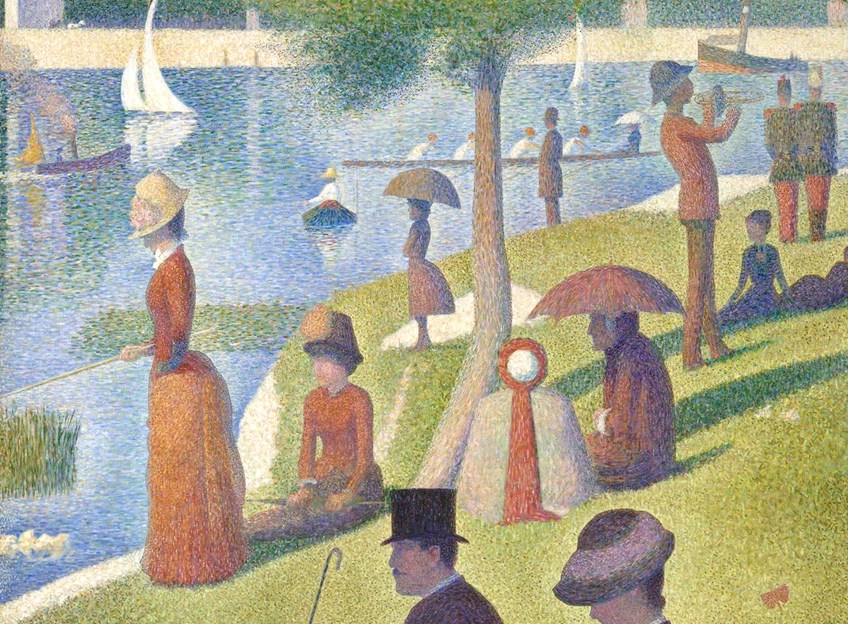
As we move further along, there is a man standing and playing the trumpet while not far from him, we see two soldiers standing upright. There is a girl running in the middle ground, the only apparent lively figure in the scene. There is a couple standing holding their baby, and another dog towards the background sniffing at the grass. There is a woman being rowed in a boat by what appears to be four rowers, and another boat far in the distance with what resembles the French flag.

In the center of the composition, there is a woman and a little girl wearing a white dress to her right (our left), both appear to be walking in our direction. The woman is holding a reddish-orange parasol in her left hand (our right) and the girl next to her almost to be looking directly at us.
There are multitudes of figures of all walks of life walking about or sitting, taking in the natural environment, giving us the impression of complete relaxation and leisure – a typical sunny Sunday afternoon.
La Grande Jatte Meaning
There has been scholarly debate as to why Seurat included certain motifs in the painting, possibly alluding to prostitution that took place on the island, where clients would meet. Two notable motifs include the woman to the left with the fishing rod and the woman to the right with the monkey.
The fishing rod could be suggestive of the idea of “fishing” for a possible desirable woman or that the prostitutes fished for prospective clients. The female monkey’s name in French was singesse, which was also a term utilized for prostitutes. The woman on the right could be with a client.

Furthermore, if we look at Seurat’s meaning from this perspective it provides another narrative that is not as vibrant as the colors that make the scene. It suggests a time in 19th century Paris related to lascivious dealings between women and men, and the little girl in white, right in the center of it all, suggests an idea of purity or innocence.
This central figure has been described as possibly questioning the Parisian ideals and morals, and the class of people around her and their fate. However, could this also touch upon the idea that this might be her fate when she grows up? Seurat leaves it open to interpretation.
Color and Technique
Seurat painted A Sunday Afternoon on the Island of La Grande Jatte in various stages. According to the studies of the Conservation Microscopist, Inge Fiedler, from the Art Institute of Chicago, Seurat painted La Grande Jatte in three stages. He applied paint at a later stage due to his revised knowledge of color theory.
These three stages were as follows: the first was when Seurat started the painting in 1884 until around 1885. Stage two was when he “reworked” the painting from 1885 to 1886, and the third stage was when he added the border around the painting in 1888; he also added a few touch-ups.
During the first stage, he applied colors that were reportedly earthy, like ochre and other colors like burnt sienna, emerald green, vermillion, iron oxide yellow, viridian, blues like cobalt, and ultramarine, red lake, and others including black.

It was during his second stage that he reportedly added his “dots”, which consisted of small brushstrokes or “dabs”. His palate was also unmixed, and he applied the colors next to the other. This is also evident in the manner Seurat painted the border. When Seurat utilized the zinc yellow pigment to accentuate the sunlight, it started to chemically react and turned to a “brownish yellow” color.
This yellow also reacted when Seurat mixed it with other colors and formed darker areas on the painting that was undoubtedly undesired.
An example of this discoloration is evident on the book covers that are next to the woman who appears to be knitting next to the man smoking his pipe, this towards the left of the composition. Reportedly, these book covers would have been “bright yellow-orange of contemporaneous paperbacks”.

The “Confetti Painter”
Seurat was dubbed as the “Confetti painter” because of the peculiar new style that he introduced into a conservative art world. However, apparently, even some of the Impressionists did not want to exhibit their paintings alongside Seurat’s. Furthermore, because of A Sunday Afternoon on the Island of La Grande Jatte size, approximately 7 by 10 feet, its effects were emphasized.
In our 21st-century pop culture we can see the painting La Grande Jatte reprising its role in television shows like The Simpsons, The Office (the US adaptation), and films like Ferris Bueller’s Day Off (1986) and Looney Tunes: Back in Action (2003), among others.
Nevertheless, Seurat introduced something completely different to what the Impressionists depicted; where they were more spontaneous, Seurat was more “mathematical” in his planning. He gave the painting the time it needed to become a masterpiece, showing the world, which was 19th-century Paris at the time, a new avenue of art.
Take a look at our A Sunday on La Grande Jatte webstory here!
Frequently Asked Questions
Who Created the Lazy Sunday Afternoon Painting?
The Neo-Impressionist painter, Georges Seurat, created the oil painting titled A Sunday Afternoon on the Island of La Grande Jatte in 1884. It depicts various Parisians from the city relaxing at leisure on a green embankment by the River Seine.
What Was Georges Seurat’s Painting Technique?
Georges Seurat was identified as a Neo-Impressionist, he innovated the new technique called Pointillism, or Divisionism, which he referred to as Chromoluminarism. This consisted of applying “dots” that were individual brushstrokes next to the other that enabled the viewers’ eyes to naturally blend colors instead of blending colors while painting.
How Are Impressionism and Post-Impressionism Different?
Impressionism was characterized as being more expressive and spontaneous in its style, depicting moments as they appeared, as well as natural lighting. They painted en plein air, which means “outdoors”. Neo-Impressionism was regarded as more precise and “conscious” in rendering a composition, and some art critics thought it was more scientific in its approach in terms of how colors were applied.
A Sunday Afternoon on the Island of La Grande Jatte Size?
Georges Seurat’s painting A Sunday Afternoon on the Island of La Grande Jatte measures to around 207.6 by 308 centimeters, which is around 7 by 10 feet.
Isabella studied at the University of Cape Town in South Africa and graduated with a Bachelor of Arts majoring in English Literature & Language and Psychology. Throughout her undergraduate years, she took Art History as an additional subject and absolutely loved it. Building on from her art history knowledge that began in high school, art has always been a particular area of fascination for her. From learning about artworks previously unknown to her, or sharpening her existing understanding of specific works, the ability to continue learning within this interesting sphere excites her greatly.
Her focal points of interest in art history encompass profiling specific artists and art movements, as it is these areas where she is able to really dig deep into the rich narrative of the art world. Additionally, she particularly enjoys exploring the different artistic styles of the 20th century, as well as the important impact that female artists have had on the development of art history.
Learn more about Isabella Meyer and the Art in Context Team.
Cite this Article
Isabella, Meyer, “A Sunday Afternoon on the Island of La Grande Jatte – An Analysis.” Art in Context. December 8, 2021. URL: https://artincontext.org/a-sunday-afternoon-on-the-island-of-la-grande-jatte/
Meyer, I. (2021, 8 December). A Sunday Afternoon on the Island of La Grande Jatte – An Analysis. Art in Context. https://artincontext.org/a-sunday-afternoon-on-the-island-of-la-grande-jatte/
Meyer, Isabella. “A Sunday Afternoon on the Island of La Grande Jatte – An Analysis.” Art in Context, December 8, 2021. https://artincontext.org/a-sunday-afternoon-on-the-island-of-la-grande-jatte/.





